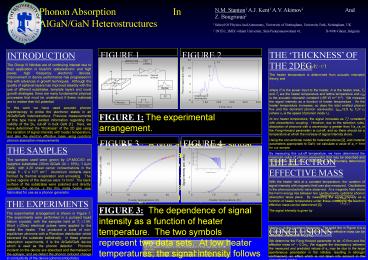Phonon Absorption In AlGaN/GaN Heterostructures - PowerPoint PPT Presentation
1 / 1
Title:
Phonon Absorption In AlGaN/GaN Heterostructures
Description:
INTRODUCTION The Group III Nitrides are of continuing interest due to their application in blue/UV optoelectronic and high power, ... – PowerPoint PPT presentation
Number of Views:51
Avg rating:3.0/5.0
Title: Phonon Absorption In AlGaN/GaN Heterostructures
1
Phonon Absorption In
AlGaN/GaN Heterostructures
N.M. Stanton1 A.J. Kent1 A.V. Akimov1
And Z. Bougrioua2
1 School Of Physics And Astronomy, University of
Nottingham, University Park, Nottingham, UK 2
INTEC, IMEC-Ghent University, Sint-Pietersnieuwstr
aat 41, B-9000 Ghent,
Belgium
THE THICKNESS OF THE 2DEG The heater
temperature is determined from acoustic mismatch
theory, and where P is the power input to the
heater, A is the heater area, Th and T? are the
heater temperature and lattice temperature and
?eff is the acoustic mismatch constant (56 W m-2
K-4). We measure the signal intensity as a
function of heater temperature. As the heater
temperature increases, so does the total emitted
phonon flux and the dominant phonon wavevector,
qdom2.8 kB Th/? v? (where v? is the speed of
phonon mode ?). At low heater temperature, the
signal increases as Th5 consistent with
piezoelectric coupling. However, due to the
selection rules, absorption of phonons with a
wavevector q greater than 1/ao (ao is the
Fang-Howard parameter) is cut-off, and so there
should be a temperature at which the increase of
signal intensity slows. Using the conventional
model for heterostructures 2, and material
parameters appropriate to GaN, we calculate a
value of ao 1nm for our sample. By measuring
this cut-off temperature, we have determined the
maximum value of phonon wavevector that may be
absorbed and deduced the value of ao. We find
the experimentally determined value of ao 0.5
nm.
INTRODUCTION The Group III Nitrides are of
continuing interest due to their application in
blue/UV optoelectronic and high power, high
frequency electronic devices. Improvement in
device performance has progressed in line with
advances in growth techniques. Although the
quality of epitaxial layers has improved steadily
with the use of different substrates, template
layers and novel growth strategies, there are
many fundamental physical processes that must be
understood if these materials are to realise
their full potential. In this work we have used
acoustic phonon spectroscopy to probe the
electronic states in an AlGaN/GaN
heterostructure. Previous measurements of this
type have yielded information regarding the
validity of the 2kF cut-off in bulk GaN 1.
Here, we have determined the thickness of the
2D gas using the variation of signal intensity
with heater temperature, and also the electron
effective mass using cyclotron phonon absorption
measurements.
THE SAMPLES The samples used were grown by
LP-MOCVD on sapphire substrates (30nm AlGaN (Al
? 16), 1.4?m GaN), with 4.2K sheet carrier
concentrations in the range 5 - 9 x 1012 cm-2.
Aluminium contacts were formed by thermal
evaporation and annealing. The active regions of
the devices were 1x1mm2. The back surface of the
substrates were polished and directly opposite
the device, a thin film metal heater was
fabricated for use as a phonon generator.
THE ELECTRON EFFECTIVE MASS With the heater held
at a constant temperature, the variation of
signal intensity with magnetic field was also
measured. Oscillations in the phonoconductivity
were observed. At a magnetic field where the
Fermi energy lies between two Landau levels,
cyclotron phonon absorption takes place. By
measuring the signal intensity as a function of
heater temperature under these conditions, the
electron effective mass can be determined
3. The signal intensity is given by where
?c is the cyclotron frequency. The solid line in
Figure 4 is a fit to this expression, from which
the electron effective mass can be extracted. We
find m 0.2 me.
THE EXPERIMENTS The experimental arrangement is
shown in Figure 1. The experiments were
performed in a pumped liquid helium cryostat,
with the samples held at T? ?1.5K. Short (?20ns)
electrical pulses were applied to the metal film
heater. This produced a burst of non-equilibrium
phonons with a Planckian distribution which
traversed the substrate ballistically. In these
phonon absorption experiments, it is the
AlGaN/GaN device which is used as the phonon
detector. Phonons incident on the device are
absorbed and thermalised in the epilayer, and we
detect the phonon induced change in conductivity
of the device (phonoconductivity).
CONCLUSIONS We determine the Fang-Howard
parameter to be ?0.5nm and the effective mass m
? 0.2me. We suggest the discrepancy between the
measured and predicted values of ao may be due to
the large spontaneous polarisation in the
nitrides, resulting in stronger confinement, an
effect which is not taken into account in the
conventional model.
REFERENCES 1 N M Stanton, A V Akimov, A J
Kent, T S Cheng and C T Foxon Appl. Phys. Lett.
78 1089 (2001) 2 T Ando, A B Fowler and F
Stern Rev. Mod. Phys. 54 437 (1982)
3 A J Kent, R E Strickland, K R
Strickland and M Henini Phys. Rev. B. 54 2019
(1996)































